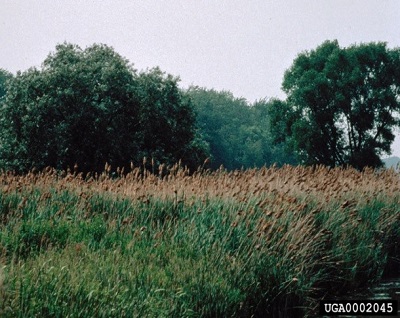Phragmites (Phragmites australis)- September 2014
Download this weed post on Phragmites as a PDF
Phragmites australis is widely distributed across the globe. Three separate lineages occur in North America – one native (sub-species (ssp.) americanus), one whose nativity is unknown and occurs in the southern U.S. (ssp. berlandieri, Gulf Coast lineage), and one introduced from the Middle East and invasive (ssp. australis). This Weed Post focuses on the invasive subspecies australis, which is often referred to simply as “Phragmites” or “common reed.”
Identification

Photo by Bernd Blossey, Cornell University, Bugwood.org
Phragmites is an erect perennial grass that typically grows 6-15 feet high and has
large (5-15 inches), feathery and plume-like inflorescences typically with a purple
or golden hue. Stems are cane-like and up to 1 inch in diameter. Distinguishing between
native and invasive Phragmites is difficult, and multiple traits should be
considered. See table below for key features to examine between native and invasive
Phragmites.
Impacts
Invasive Phragmites is very aggressive and can create dense monocultures that may alter wetland hydrology, increase fire potential, and degrade wildlife habitat of wetland-dwelling species.
Habitat
Native and introduced Phragmites habitats overlap extensively and include wetlands (both freshwater and brackish), along lakes, streams, and rivers, and near springs. Invasive Phragmites may be more likely to occur in disturbed sites like roadsides and railways, construction sites, and near agricultural fields.
Spread
Plants spread by seed which is dispersed via wind and water. Phragmites can also spread through the movement of rhizomes, stolons, and their fragments.
Current status and management
Phragmites is a state-listed noxious weed in the following north-western states: Colorado, Idaho, Nebraska, Oregon, and Washington. It is currently under review for listing in Montana after being petitioned for listing in 2013. In August 2014 a population of P. australis ssp. australis was confirmed in Hill County, MT. This is believed to be the first confirmed population in Montana, although this population has likely been present for some time. Management is challenging and usually requires integrating mechanical, biological, and chemical methods. See the following publication from University of Nebraska Lincoln Extension for more information.
|
Features
|
Native Phragmites
|
Exotic Phragmites
|
|---|---|---|
|
*Leaf sheath
|
Loose, fall away from stem; do not persist
|
Adhere tightly to stem; persistent |
|
*Glumes (bracts at base of grass
spikelet; usually 2, an upper and a lower) |
Upper glume much longer (5-11 mm)
Lower glume longer (>4 mm) |
Upper glume shorter (4.5-7.5 mm)
Lower glume short (<4 mm) |
|
*Stem density
|
Less dense, typically mixed with other species; stems less persistent into next growing
season
|
Often grows in monoculture with high stem density; stems often persist into next growing
season
|
|
Spots on stems
|
May be present due to a native fungus
|
No spots, but maybe dark smudges due to mildew
|
|
Leaf color
|
Yellow-green to dark green
|
Dark green
|
|
Stem texture/color (observable when sheath is removed)
|
Smooth, shiny; reddish
|
Slightly ridged, not shiny; green to tan
|
*Most reliable features; adapted from Swearingen and Salton (2010) (Great tips on identification!)
View the MSU Extension Publication "Watch Out for Phragmites"
